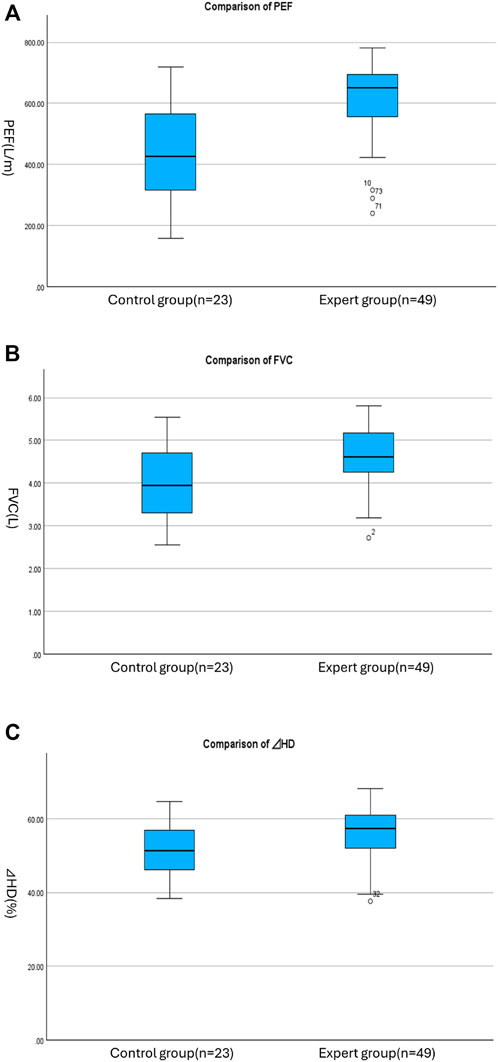- 1Tokyo Metropolitan Institute for Geriatrics and Gerontology, Tokyo, Japan
- 2Jodo Shu Research Institute, Tokyo, Japan
- 3Shingon Shu Buzan-ha, Chiba, Japan
- 4Institute of Regional Development, Taisho University, Tokyo, Japan
- 5Faculty of Socio-Symbiosis, Taisho University, Tokyo, Japan
Introduction: There is limited prior research on the physiological effects of sutra chanting.
Methods: The health effects of sutra chanting were explored by comparing the oral and respiratory functions of Buddhist priests who are experts in sutra chanting with those of general Buddhist priests. In addition to basic characteristics, lifestyle variables, and general health status, participants underwent assessment of oral function and respiratory function by two certified dentists.
Results: Compared to general priests (n = 23), expert chanters (n = 49) were significantly higher in peak expiratory flow (PEF), forced vital capacity (FVC), and hyoid displacement (⊿HD). In the two multiple regression analyses which include PEF and FVC as the dependent variables, expert group demonstrated significantly better function.
Discussion: Considering its historical and cultural background, the idea of using sutra chanting has potential in a healthcare program for older people at risk of declining oral and respiratory functions.
1 Introduction
Mindfulness is an accepted intervention in older adults with various health concerns (Hazlett-Stevens et al., 2019) and Japanese Buddhism is the origin of mindfulness (Kabat-Zinn, 2003). Zazen, which has influenced mindfulness, is one of the two most important practices in Japanese Buddhism. Sutra chanting is another important practice of Japanese Buddhism.
In Japan, Buddhist practitioners are encouraged to perform repetitive and loud recitations of Buddhist sutras, which contain teachings, every morning in search of mental peace. Listening to sutra chanting reduces bereavement stress (Taniyama et al., 2021). Sabdavidya shomyo (声明) (Seroussi, 2002) is the chanting of Buddhist hymns by experienced priests, the traditional sound of voices used in religious ceremonies as offerings to Buddha (Figure 1). Chanting involves a special vocalization method that uses an extended breathing technique with a fixed rhythm and pitch. According to oral science, sutra chanting may have health benefits. However, compared to Zen meditation, research on the effect of sutra chanting on health outcomes is limited.
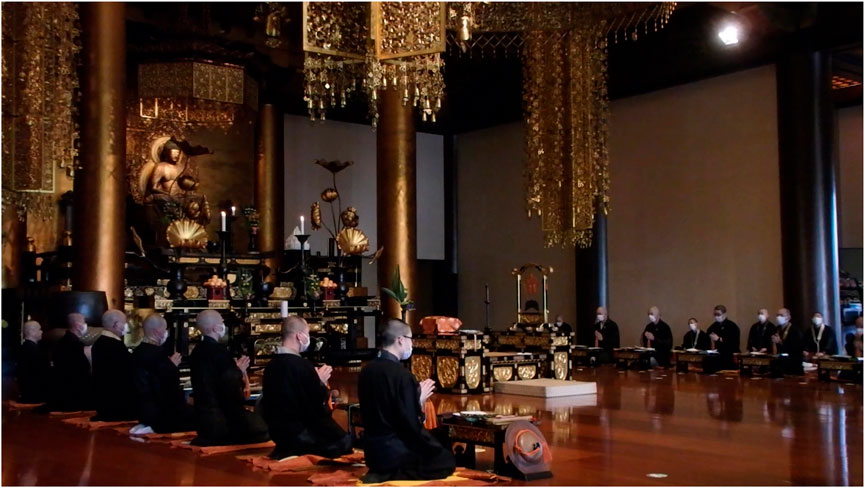
Figure 1. Religious ceremony in which experienced priests chant a Sabdavidya “shomyo” offering to the Buddha.
Generally, respiratory function decreases with aging (Thomas et al., 2019) and the incidence of aspiration pneumonia is high among older adults in Japan (Teramoto et al., 2008). The Pa-Ta-Ka-Ra exercise is commonly used to prevent aspiration pneumonia (Hara et al., 2012). In this exercise, tongue movements are used to generate sounds as repeated syllables (e.g., Ta-ta-ta-ta-ta and Ka-ka-ka-ka-ka) that are characteristic of Japanese linguistic constructions. In addition, older adults at risk of oral hypofunction and dysphagia are asked to perform repetitive exercises involving syntactic sound sequences that are not part of daily words (e.g., Pa-ta-ka-ra). However, clinically, patients often state that meaningless vocalizations are boring. Vocalization has favorable effects. Moreover, singing is used in respiratory rehabilitation (Kim et al., 2023). Karaoke, a popular interactive leisure activity worldwide following the development of the karaoke machine in Japan in the 1970s, involves long phonation and reportedly im-proves respiratory function (Miyazaki and Mori, 2020).
In 2010, the number of Buddhists worldwide was 488 million, representing 7% of the world’s population (Pew Research Center, 2012). Considering its popularity among Buddhists, if sutra chanting is related to better oral and respiratory function, it could expand the possibility of developing a novel intervention for older adults, especially in Asia.
As there is limited prior research on the physiological effects of shomyo sutra chanting, this exploratory study was designed to investigate the effects of sutra chanting by comparing the oral and respiratory functions of expert Buddhist priests with those of general Buddhist priests.
2 Materials and methods
2.1 Participants
The participants comprised Buddhist priests who were expert (expert group) or nonexpert (control group) in shomyo sutra chanting. Shomyo is a special vocalization method using very long breathing techniques with a fixed rhythm and pitch, which is the chanting of Buddhist hymns for religious ceremonies. Among the priests of the Jodo denomination, a group of priests called Shiki-shi perform these religious musical ceremonies. The experts in this study are not defined by specific objective criteria; rather, they are the Shiki-shi priests who specialize in shomyo sutra chanting. They practice diligently every day, gather twice a year for joint practice sessions, and participate in an annual presentation event to refine their ceremonial chanting skills throughout the year. The expert priests who participated in our study were those who came to Tokyo for one of these biannual practice sessions at Zojoji Temple, the head temple of the Jodo denomination in eastern Japan. The control group was recruited from Zojoji Temple, where they worked as managers of the denomination.
The expert group consisted solely of male priests, which was determined by historical factors and beyond our control. Therefore, we did not recruit female priests as controls.
The expert group was measured on 29 June 2022 and the control group on 3 October 2022. One month before the measurement, potential participants were informed of the date and location of the survey and asked to come to the venue.
2.2 Measures
2.2.1 Oral function
Objective assessment of oral health status was performed by two dentists as described below; Participants underwent an oral examination that included the number of teeth and denture use, conducted by two dentists.
General oral health status was assessed using the Oral Health Assessment Tool - Japanese Version (OHAT-J) (Matsuo and Nakagawa, 2016). OHAT-J is an evaluation tool that assesses the lips, tongue, gums and tissues, saliva, natural teeth, dentures, oral cleanliness, and dental pain through comprehensive observational evaluation (Chalmers et al., 2005), and is widely used internationally.
Oral diadochokinesis (ODK) was assessed by instructing participants to rapidly and repeatedly articulate the monosyllables/pa/,/ta/, and/ka/for 5 s. The number of articulations was recorded and converted into a score expressed as repetitions per second (Sakayori et al., 2013). A digital counter (T.K.K. 3,350; Takei Rika Kikai, Niigata, Japan) was used to perform the ODK test, which serves as an index of lip and tongue motor function.
Occlusal pressure was measured using Dental PrescaleⅡ® (GC, Tokyo, Japan), which is a pressure-sensitive sheet to measure occlusal pressure (Hara et al., 2020). The sheet contains microcapsules that rupture under pressure, releasing dye to visualize contact points between the upper and lower teeth in varying shades of red—darker red indicating stronger contact. The sheets were scanned using an image scanning system (Bite Force Analyzer, GC, Tokyo, Japan) to quantify both the total occlusal pressure and the pressure exerted in the denture or natural tooth areas. Measurements were taken under the following standardized conditions: the participant wore dentures, sat in an upright position, held the dorsum of the tongue parallel to the floor, and bit down with maximal force for 3 s.
Oral moisture was measured using the oral moisture-checking device (Mucus®, Life Co., Saitama, Japan), which evaluates electrostatic capacity based on impedance caused by high-frequency waves (Takahashi et al., 2006). This method reflects both surface and subsurface (up to 50 μm deep) mucosal moisture. Measurements were taken at the center of the tongue’s underside, 10 mm from the tip, using a disposable-covered sensor applied with approximately 200 g of pressure. Three measurements were taken, and the median value was used (Fukushima et al., 2019).
The maximum phonation time (MPT) was used to evaluate exhalation and vocal function because it has been found to have a significant relationship with swallowing and coughing functions (Zhou et al., 2012). A cutoff value of 10 s is commonly used. The measurement was performed by having the subject sit upright and sustain the sound “ah” for as long as possible, with the duration recorded. The pitch was at a natural speaking level, and the intensity was at a natural moderate level, avoiding overly weak or strong voices. The measurement was conducted three times consecutively, and the maximum value was adopted.
Hyoid displacement (⊿HD) was measured using a portable ultrasound device (iViz Air convex type, Fujifilm, Japan) by a dentist certified in swallowing therapy. Participants were seated, facing forward, and instructed to perform a saliva effort swallow. The anatomical landmarks for measurement were the mandible, hyoid bone, and geniohyoid muscle. The probe was positioned in a sagittal direction, perpendicular to the geniohyoid muscle (Figure 2). For image acquisition, measurements were taken at two timings—at rest and during maximum displacement of a saliva effort swallow—for three sets, and a video was also recorded for confirmation. We used Winiker’s technique (Winiker et al., 2021). The ultrasound probe was positioned at a right angle to the mandible, geniohyoid muscle, and hyoid bone, ensuring that the hyoid bone was clearly visualized. Measurements were taken at a depth of 7–10 cm, using a frequency of 4 MHz and a single-focus setting, to determine the hyoid rest position and maximum displacement. ⊿HD (%) was calculated using the following formula for body size correction. The ⊿HD was calculated for each of the three measurement sets using the formula below, and the maximum ⊿HD value from these sets was used for analysis.
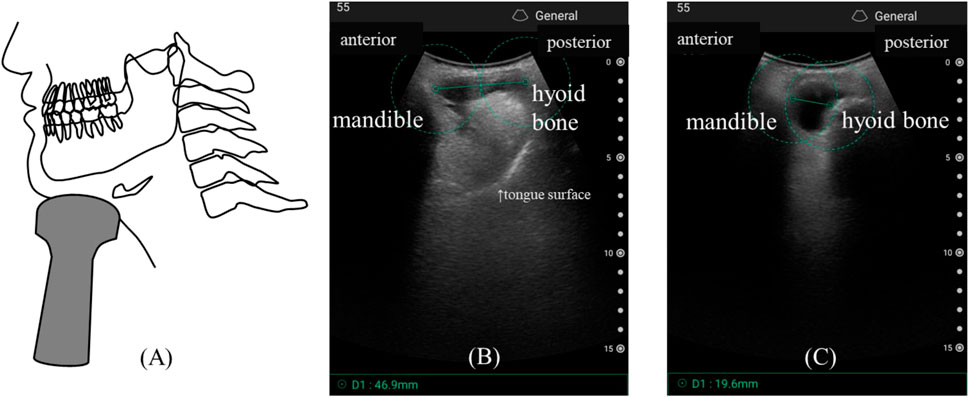
Figure 2. Ultrasound probe placement for assessing hyoid bone displacement (A), and ultrasound images showing the hyoid bone’s resting position (B) and maximum displacement (C). Measurements were performed using the caliper function in the FUJIFILM iViz air application. The straight-line distance from the mandibular border to the anterior border of the hyoid bone was measured according to Winiker’s technique. The upper shadow in the image represents the geniohyoid muscle.
Subjective oral health status was assessed using questions concerning having subjective oral difficulty in gargling, having subjective difficulty in chewing, and having subjective choking on swallowing fluids, with potential answers of yes and no.
2.2.2 Respiratory function
We measured participants’ respiratory function using portable devices rather than full-specification spirometers, in order to avoid damaging the temple’s wooden furnishings. Forced vital capacity (FVC) was measured using a Portable Dry Spirometer (Tsutsumi KC, Japan). We asked participants to take a deep breath, place the mouthpiece in their mouth, exhale completely in one go, continue exhaling for at least 6 s, and do this 3 times. Peak expiratory flow (PEF) and forced expiratory volume in 1 s (FEV 1.0) were measured using an electrical peak-flow meter (Asuma One, Japan). We asked participants to take a deep breath, place the mouthpiece in their mouth, exhale completely in one go, and continue exhaling for at least 6 s. All three respiratory function tests were performed in a seated position with a device held parallel to the floor and with the nose clip. All of the three measurements were conducted by one dentist certified in swallowing function therapy. The maximum values were used for the analysis. The reliability of repeated measurements was adjusted in advance before the test was conducted.
2.2.3 Other variables
We measured physical variables that may affect oral and respiratory functions, such as age, body weight (BW) (kg) and body height (BH) in meters, grip strength (kg), and smoking habits, using the Brinkman Index (Brinkman and Coates, 1963) and skeletal muscle mass index (SMI) as the indicator of frailty (Janssen et al., 2000). Grip strength was measured using a Smedley-type digital grip dynamometer (T.K.K.5401 GRIP-D; Takei Rika Kikai, Niigata, Japan) with the patient in a standing position. The dominant hand was determined as the preferred hand used to eat and write. Each measurement was taken twice on the dominant hand with an interval of at least 30 s between each measurement, and the maximum value was used for analysis. Skeletal muscle mass was measured using the body composition analyzer (InBody S10, Biospace Co., Ltd., Seoul, Korea). The SMI was calculated as the appendicular muscle mass in kilograms divided by the square of the height in meters. All participants’ skeletal muscle mass was measured while seated, at a fasting timing, with probes placed on both hands and feet.
In addition, respondents were asked about their weekly sutra chanting time using the options; “below 1 h”, “at least 1 h”, “at least 2 h”, “at least 4 h”, “at least 6 h”, “at least 8 h”, and “at least 10 h”. We adopted the minimum time spent on sutra chanting as a numerical value. Sutra-chanting time was binarized using a threshold of 6 h, We also asked their engagement in leisure activities involving their voices (e.g., karaoke or rock and roll band) other than sutra chanting.
Furthermore, we interviewed whether the participants had the following diseases; hypertension, cerebral stroke, heart disease, diabetes, hyperlipidemia, gastrointestinal disease, respiratory disease, kidney and prostate disorders, musculoskeletal disorders, cancer, immune disorder, depression, and Parkinson’s disease.
Finally, researchers confirmed that all subjects were not suffering from a cold and did not have a blocked nose.
The measurement setup is depicted in Figure 3.
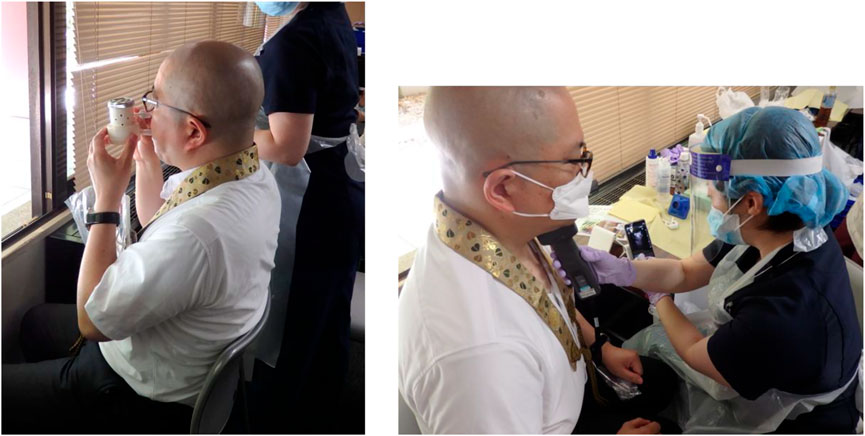
Figure 3. The dentist checked a Buddhist priest’s oral function, respiratory function (left), and hyoid bone displacement by ultrasonic examination (right).
2.3 Statistical analysis
In this study, MPT, ⊿HD, PEF, FEV1.0, and FVC were each measured three times, and the maximum value was used for the analysis. To ensure the validity of this approach, the consistency across the three measurements was examined using the intraclass correlation coefficient (ICC) and the standardized difference (Cohen’s d). Student’s t-test and the chi-squared test were used to analyze continuous variables and categorical data, respectively. Then, the items that showed statistical significance in the simple analysis from oral and respiratory function items were used as the dependent variable of multiple analyses.
A multiple regression analysis for PEF, FVC, and ⊿HD were conducted to confirm the effect of being in the expert group, adjusting for mediating variables. Because the number of participants did not allow for the inclusion of many variables in the multivariate analysis, we decided, after discussion with healthcare professionals, to include age, grip strength (kg), occlusal pressure (N), BH(m), smoking habit (Brinkman index), sutra-chanting time (>6 h), leisure activity using voice, and being in the expert priest group as independent variables. Variables generally related to respiratory and swallowing function, as well as those with potential influence within a priest’s activities, were selected and adopted after confirming for multicollinearity among the independent variables using the Variance Inflation Factor (VIF). Although SMI, which showed a significant difference between groups, was initially considered for inclusion in the model, a model including height was ultimately selected because it had a higher adjusted R2. As a result, all independent variables had a VIF below 2.0, which is well below the generally acceptable threshold of 10, and therefore, multicollinearity was not considered a problem.
2.4 Positionality
The study team consisted of a dentist and an oral health researcher, a medical doctor, a psychologist, university professors who were Buddhist priests, and Buddhist priests from different denominations. None of the participants engaged in religious behavior or proselytizing. This study was not intended to benefit any particular religion or denomination; rather, to explore a brand-new method of promoting oral and respiratory wellbeing from existing resources. This study was funded by a secular research grant.
Furthermore, we do not intend to claim that religious practice is valuable due to medically verified evidence. Conversely, by evaluating medical research methodology and revealing the medical benefits of purely religious practices, we aimed to raise awareness in the medical community, which is faced with several challenges such as increasing patient numbers with respiratory pneumonia due to societal aging.
2.5 Ethical considerations
The research was completed in accordance with the Declaration of Helsinki as revised in 2013. The participants provided informed consent. The study protocol was approved by the Ethics Committee of Taisho University (approval number: 22–9).
Written informed consent was obtained from all individual participants included in the study. The authors affirm that human research participants provided informed consent for publication of the images included this manuscript, i.e., Figures 1, 3.
2.6 Data availability statement
The authors confirm that the data supporting the findings of this study are available within the article and its supplementary materials, which is available at 10.6084/m9. figshare.30112051.
3 Results
Seventy-two priests participated in this study, 49 and 23 in the expert and control groups, respectively. All participants were male, as explained above.
Concerning the oral functions, ⊿HD showed a significant difference (55.8 ± 6.9 vs51.4 ± 7.3, p = 0.015) between the two groups indicating that sutra chant experts have better swallowing function; however, number of teeth, denture use, OHAT, oral diadochokinesis, occlusal pressure, oral moisture, MPT, difficulty in gargling, difficulty in chewing, and choking on swallowing fluids did not show difference. Concerning the respiratory function, PEF (617.3 ± 125.4 vs. 443.8 ± 156.5, p < 0.001) and FVC (4.6 ± 0.7 vs. 4.0 ± 0.9, p = 0.001) showed a statistically significant difference (Figure 4). Basic characteristics such as age, BH, BW, BMI, grip strength, lifestyle variables that affect oral and respiratory function such as smoking, sutra-chanting time, having leisure activity using voice, and general health status did not differ between the two groups. Only the SMI showed the superiority of the expert group (8.7 ± 0.8 vs. 8.3 ± 0.6, p = 0.020). The comparative characteristics of the two groups are presented in Table 1.
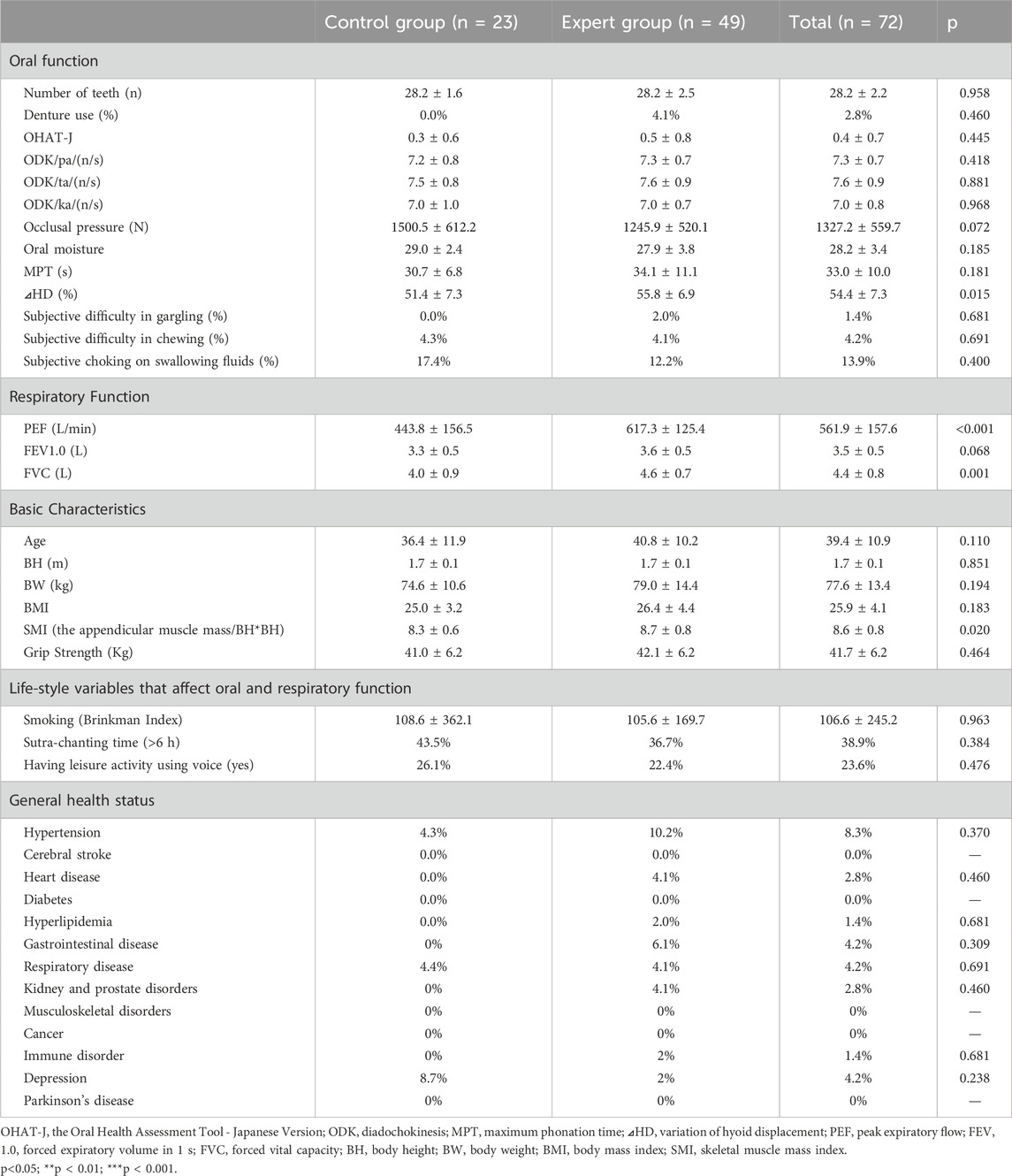
Table 1. Comparative characteristics of Buddhist priests who are experts in shomyo sutra chanting (expert group) and Buddhist priests who are not (control group).
Multiple regression analyses, including PEF, FVC, and ⊿HD as the dependent variables, were conducted to confirm the effect of the expert group, which was shown in simple analyses (Tables 2). In the two multiple regression analyses which include PEF and FVC as the dependent variables, expert group demonstrated significantly better function (p < 0.001 and p = 0.001). However, in the analysis which includes ⊿HD as the dependent variable, expert group showed only a nonsignificant trend (p = 0.052). Assessing the model fit for the multiple regression models for PEF, FVC, and ⊿HD, the coefficients of determination (R2) were 0.414, 0.379, and 0.146, respectively. Furthermore, the adjusted R2values, which account for the number of variables, were 0.340, 0.300, and 0.038, respectively, demonstrating the validity of the model.
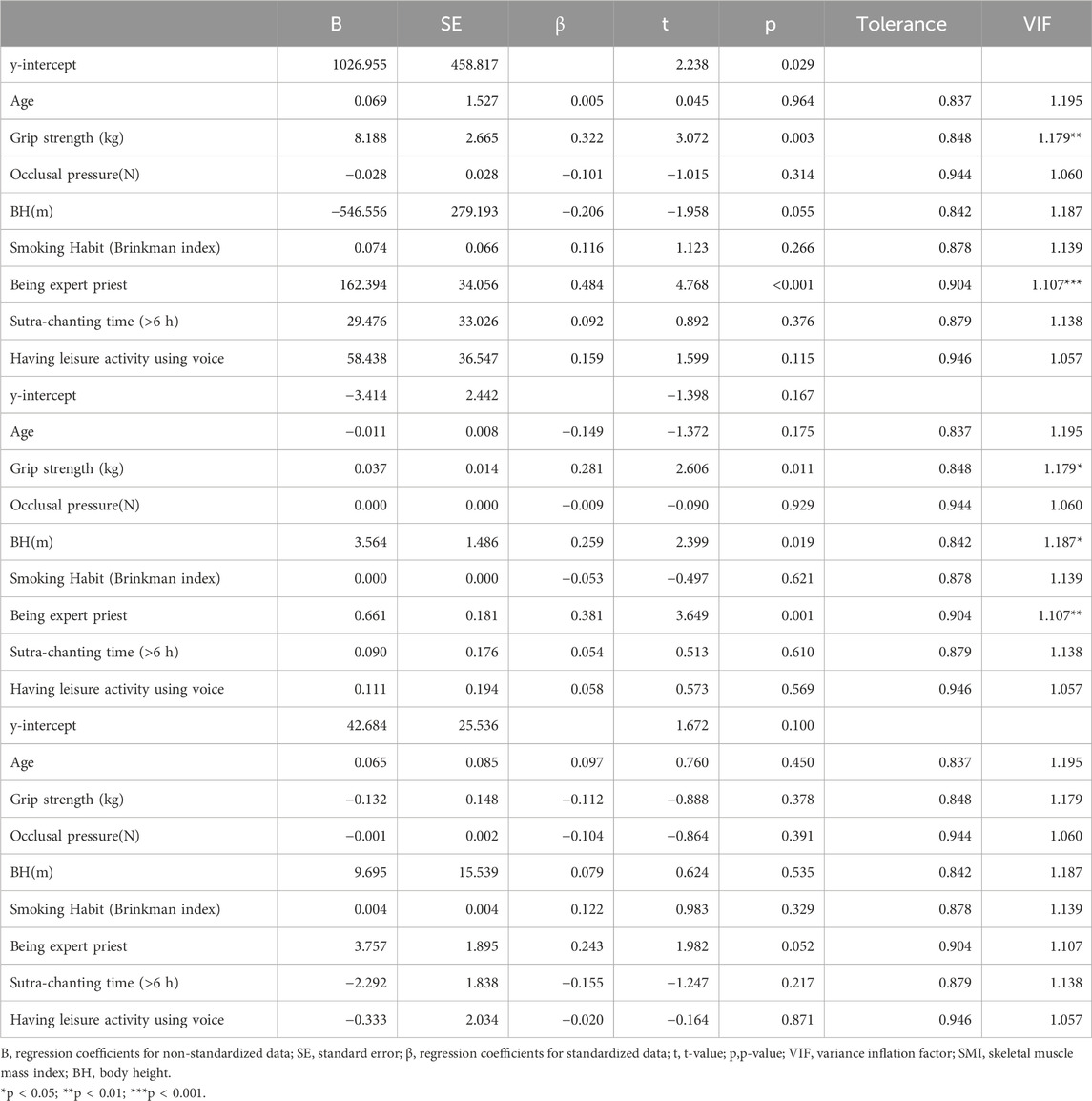
Table 2. Results of the analysis. Effect of expert group in 3 models of multiple regression analyses which includes PEF, FVC, and ⊿HD as the dependent variables (Table 2).
To confirm the consistency of the three repeated measurements of MPT, ⊿HD, PEF, FEV1.0, and FVC, ICCs were calculated. The results showed high consistency across all measurement items. Specifically, the ICCs were as follows: MPT (ICC = 0.952, 95% CI [0.930–0.969]), ⊿HD (ICC = 0.771, 95% CI [0.771–0.850]), PEF (ICC = 0.948, 95% CI [0.923–0.966]), FEV1.0 (ICC = 0.902, 95% CI [0.855–0.936]), and FVC (ICC = 0.966, 95% CI [0.950–0.978]). Although potential learning effects and fatigue across the three functional tests were assumed, the standardized differences (Cohen’s d) were all small (<0.5; Cohen’s d = −0.29, −0.04, −0.19, −0.21, −0.37). Even when statistically significant differences were observed, their effects were judged not to be clinically meaningful. Based on this high consistency, the small effect sizes, and the international guideline recommendations (ATS/ERS) to adopt the maximum value from multiple measurements (Graham et al., 2019), we concluded that the use of maximum values in this study was appropriate.
4 Discussion
In this study, the oral and respiratory functions of Buddhist priests who are expert at chanting sutras and general priests were compared. The results of this study indicate that being a sutra chanting expert was related to having better oral and respiratory functions. To our knowledge, sutra chanting has rarely been assessed medically and scientifically, our results provided new insights into the relationship between health and religious customs despite its small sample size.
Engaging in activities that utilize oral and respiratory function has been reported to contribute to better health outcomes among older people. A fMRI study revealed increased activity in the right angular gyrus and the left lingual gyrus after the music therapy intervention (Satoh et al., 2015). Music therapy is regarded as a promising intervention method for people with Alzheimer’s disease in the psychosocial domain (Matziorinis and Koelsch, 2022). Similarly, reading aloud is reported to relate to better cognitive function (Kulason et al., 2018). Regarding studies that have used oral and respiratory function as an outcome measure, singing is used in respiratory rehabilitation (Kim et al., 2023). Karaoke, a popular interactive leisure activity worldwide following the development of the karaoke machine in Japan in the 1970s, involves long phonation and reportedly improves respiratory function (Miyazaki and Mori, 2020). However, to the best of our knowledge, there was no previous literature on the effect of traditional, cultural, and religious practices that use vocalization in the context of preventing aspiration pneumonia.
The reason Buddhism-based practices have been widely accepted as health-related techniques in cultures and regions outside of Buddhism stems from the characteristics of Buddhism. Zen Master Dogen (1200–1253), the founder of zazen in Japan, described zazen as a way to transcend: “To study the Buddha Way is to study the self. To study the self is to forget the self. To forget the self is to be verified by all things. To be verified by all things is to let the body and mind of the self and the body and mind of others drop off” (Dogen, 2024). Similarly, the Eiheiji Temple, the cathedral headquarters of the Soto denomination, which is the largest Zen denomination and established by Dogen in 1244, describes zazen as “the fundamental practice, and not for the purpose of obtaining a certification of spiritual enlightenment” (Eiheiji Temple, 2012). Zazen and its global variant, mindfulness, is widely accepted in other civilizations because, superficially, they are a methodology for forgetting the trivialities of the surroundings and addressing the self. The practice does not include the teachings of a transcendent other.
The situation is similar with regard to sutra-chanting. The present study is neutral with regard to Buddhism, as described in the positionality section; The Heart Sutra has been interpreted as having cognitive-behavioral elements that teaches the abandonment of adherence to preconceptions. Heart Sutra is not very religious as it rarely teaches the transcendent other. In fact, it is becoming popular in secularism, popular music, and spirituality with modern music technologies, including samplers, electric artists, and vocaloid software (Reehl, 2021). No official English translation of the Heart Sutra exists; however, a translation of the Vietnamese version by the popular Buddhist master, Thich Nhat Hanh (Thich Nhat Hanh, 2017), is available in English.
The findings of this study can be used for social implementation. Clinically, patients often state that meaningless vocalizations, such as the Pa-Ta-Ka-Ra exercise, are boring. However, a sutra chant has a significant meaning and its sequences involve sounds not used in daily communication. It is possible that healthcare programs involving sutra chanting and focusing on oral and respiratory rehabilitation—drawing on examples such as mindfulness meditation for mental illness, which has received international attention—may have potential as supplementary or alternative approaches to conventional healthcare programs.
For implementing sutra chanting in a healthcare program, it is necessary to develop a sutra chanting program which is acceptable for the broad range of people. Buddhism is often perceived as a philosophy and means of attaining mental peace, whereas religious neutrality is required for health programs. The Heart Sutra is a good candidate for developing a sutra chant program for older adults regardless of religion. It does not advocate the superiority of any particular religion and is very short, requiring about 5 min to complete.
This study is preliminary and exploratory, and potential confounding factors were not fully examined. In particular, we did not inquire about the daily activities of the priests in either group. On the other hand, the priests in both groups belong to their own home temples and likely lead similar lifestyles, with the exception that the expert group practices as needed, while the control group priests work at their denomination’s office during the day.
This study had some limitations. 1) A primary limitation is the small sample size, and future studies with larger sample sizes are needed. 2) The participants were Buddhist priests belonging to the temple headquarters of one of the seven major denominations of Japanese Buddhism. 3) Mental health variables that potentially affect the oral and respiratory function such as depression, anxiety, and subjective stress were not assessed. 4) Nutritional status was not assessed. 5) Respiratory function was assessed by one researcher. Because this study did not use spirometry and only conducted simplified measurements, a precise evaluation of FEV1.0/FVC and PEF/FVC was difficult. While no numerical abnormalities were found and no associations were observed with age, BMI, self-reported respiratory diseases, or smoking, we did not exclude subjects based on respiratory disease. A more detailed examination of this population would require a study using standard spirometry. On the other hand, although it has been reported that incense exposure increases airway hyperresponsiveness in mice (Yamamoto et al., 2021), the respiratory function of priests who are routinely exposed to incense has not been studied. This area warrants future investigation. 6) The experts were measured in June and controls in October, which might have affected the oral and respiratory function. 7) Assessor was not blinded, which suggests the risk of measurement bias. 8) Further studies are needed to investigate potential gender differences.
5 Conclusion
This preliminary and exploratory research suggests that Buddhist priests who are expert in sutra chanting have better oral and respiratory functions than general priests. To use sutra chanting as a healthcare program for older people at risk of declining oral and respiratory functions, there are several additional challenges to be overcome. First, it will be necessary to conduct a full-scale study involving broader measurements and blinding of the assessors. Second, because the cross-sectional design of this paper has inherent limitations in determining a causal relationship, interventional study with randomization or quasi-experimental testing is needed. Third, developing the program that uses sutra-chanting and that is acceptable for the broad range of people is essential.
Data availability statement
The datasets presented in this study can be found in online repositories. The names of the repository/repositories and accession number(s) can be found in the article/supplementary material.
Ethics statement
The studies involving humans were approved by the Ethics Committee of Taisho University (approval number: 22-9). The studies were conducted in accordance with the local legislation and institutional requirements. The participants provided their written informed consent to participate in this study. Written informed consent was obtained from the individual(s) for the publication of any potentially identifiable images or data included in this article.
Author contributions
AE: Conceptualization, Data curation, Formal Analysis, Funding acquisition, Investigation, Methodology, Project administration, Resources, Writing – original draft, Writing – review and editing. CU: Conceptualization, Data curation, Formal Analysis, Methodology, Resources, Writing – original draft, Writing – review and editing. YM: Data curation, Formal Analysis, Investigation, Writing – review and editing. RS: Data curation, Investigation, Methodology, Resources, Writing – review and editing. RK: Data curation, Investigation, Methodology, Project administration, Resources, Writing – review and editing. YO: Data curation, Investigation, Methodology, Project administration, Resources, Writing – review and editing. AT: Data curation, Investigation, Methodology, Project administration, Resources, Writing – review and editing. KN: Conceptualization, Data curation, Investigation, Methodology, Project administration, Resources, Writing – review and editing. TO: Conceptualization, Data curation, Formal Analysis, Funding acquisition, Investigation, Methodology, Project administration, Resources, Writing – original draft, Writing – review and editing.
Funding
The author(s) declare that financial support was received for the research and/or publication of this article. This work was supported by the Japan Society for the Promotion of Science KAKENHI (JSPS KAKENHI Grant numbers JP19K10438 and JP22K10306) and by Research Grants in the Humanities given by the Mitsubishi Foundation (Grant ID 202220008). The funders had no role in the design, practice, or analysis of this study.
Acknowledgments
We are deeply grateful to all the participants and the Zojoji Temple, the head temple of East Japan, for providing the measuring venue.
Conflict of interest
The authors declare that the research was conducted in the absence of any commercial or financial relationships that could be construed as a potential conflict of interest.
Generative AI statement
The author(s) declare that no Generative AI was used in the creation of this manuscript.
Any alternative text (alt text) provided alongside figures in this article has been generated by Frontiers with the support of artificial intelligence and reasonable efforts have been made to ensure accuracy, including review by the authors wherever possible. If you identify any issues, please contact us.
Publisher’s note
All claims expressed in this article are solely those of the authors and do not necessarily represent those of their affiliated organizations, or those of the publisher, the editors and the reviewers. Any product that may be evaluated in this article, or claim that may be made by its manufacturer, is not guaranteed or endorsed by the publisher.
References
Brinkman, G. L., and Coates, E. O. (1963). The effect of bronchitis, smoking, and occupation on ventilation. Am. Rev. Respir. Dis. 87, 684–693. doi:10.1164/arrd.1963.87.5.684
Chalmers, J. M., King, P. L., Spencer, A. J., Wright, F. A., and Carter, K. D. (2005). The oral health assessment tool--validity and reliability. Aust. Dent. J. 50 (3), 191–199. doi:10.1111/j.1834-7819.2005.tb00360.x
Dogen (2024). Shobogenzo genjo koan volume. Available online at: https://daihonzan-eiheiji.com/en/learn.html (Accessed October 25, 2024).
Eiheiji Temple (2012). The reality of zazen. Available online at: https://daihonzan-eiheiji.com/en/learn.html (Accessed October 25, 2024).
Fukushima, Y., Sano, Y., Isozaki, Y., Endo, M., Tomoda, T., Kitamura, T., et al. (2019). A pilot clinical evaluation of oral mucosal dryness in dehydrated patients using a moisture-checking device. Clin. Exp. Dent. Res. 5 (2), 116–120. doi:10.1002/cre2.145
Graham, B. L., Steenbruggen, I., Miller, M. R., Barjaktarevic, I. Z., Cooper, B. G., Hall, G. L., et al. (2019). Standardization of spirometry 2019 update. An official American thoracic society and European respiratory society technical statement. Am. J. Respir. Crit. Care Med. 200 (8), e70–e88. doi:10.1164/rccm.201908-1590ST
Hara, S., Miura, H., Yamasaki, K., and Sumi, Y. (2012). Association between activities of daily living and oral diadochokinesis among Japanese elderly individuals in a nursing home. Nihon Ronen Igakkai Zasshi 49 (3), 330–335. doi:10.3143/geriatrics.49.330
Hara, K., Namiki, C., Yamaguchi, K., Kobayashi, K., Saito, T., Nakagawa, K., et al. (2020). Association between myotonometric measurement of masseter muscle stiffness and maximum bite force in healthy elders. J. Oral Rehabilitation 47 (6), 750–756. doi:10.1111/joor.12968
Hazlett-Stevens, H., Singer, J., and Chong, A. (2019). Mindfulness-based stress reduction and mindfulness-based cognitive therapy with older adults: a qualitative review of randomized controlled outcome research. Clin. Gerontol. 42 (4), 347–358. doi:10.1080/07317115.2018.1518282
Janssen, I., Heymsfield, S. B., Baumgartner, R. N., and Ross, R. (2000). Estimation of skeletal muscle mass by bioelectrical im-pedance analysis. J. Appl. Physiology (1985) 89 (2), 465–471. doi:10.1152/jappl.2000.89.2.465
Kabat-Zinn, J. (2003). Mindfulness-based interventions in context: past, present, and future. Clin. Psychol. 10 (2), 144–156. doi:10.1093/clipsy.bpg016
Kim, S. J., Yeo, M. S., and Kim, S. Y. (2023). Singing interventions in pulmonary rehabilitation: a scoping review. Int. J. Environ. Res. Public Health 20 (2), 1383. doi:10.3390/ijerph20021383
Kulason, K., Nouchi, R., Hoshikawa, Y., Noda, M., Okada, Y., and Kawashima, R. (2018). The beneficial effects of cognitive training with simple calculation and reading aloud (SCRA) in the elderly postoperative population: a pilot randomized controlled trial. Front. Aging Neurosci. 10, 68. doi:10.3389/fnagi.2018.00068
Matsuo, K., and Nakagawa, K. (2016). Reliability and validity of the Japanese version of the oral health assessment tool (OHAT-J). J. Jpn. Soc. Disabil. Oral Health 37, 1–7. doi:10.14958/jjsdh.37.1
Matziorinis, A. M., and Koelsch, S. (2022). The promise of music therapy for alzheimer's disease: a review. Ann. N. Y. Acad. Sci. 1516 (1), 11–17. doi:10.1111/nyas.14864
Miyazaki, A., and Mori, H. (2020). Frequent karaoke training improves frontal executive cognitive skills, tongue pressure, and respiratory function in elderly people: pilot study from a randomized controlled trial. Int. J. Environ. Res. Public Health 17 (4), 1459. doi:10.3390/ijerph17041459
Pew Research Center (2012). The global religious landscape. Washington DC: Buddhists. Available online at: https://www.pewresearch.org/religion/2012/12/18/global-religious-landscape-buddhist/ (Accessed October 25, 2024).
Reehl, D. (2021). Musicalizing the heart sutra: buddhism, sound, and media in contemporary Japan. Religions 12 (9), 759. doi:10.3390/rel12090759
Sakayori, T., Maki, Y., Hirata, S., Okada, M., and Ishii, T. (2013). Evaluation of a Japanese “Prevention of long-term care” project for the improvement in oral function in the high-risk elderly. Geriatrics and gerontology Int. 13 (2), 451–457. doi:10.1111/j.1447-0594.2012.00930.x
Satoh, M., Yuba, T., Tabei, K., Okubo, Y., Kida, H., Sakuma, H., et al. (2015). Music therapy using singing training improves psychomotor speed in patients with alzheimer's disease: a neuropsychological and fMRI study. Dementia geriatric cognitive Disord. extra 5 (3), 296–308. doi:10.1159/000436960
Seroussi, E. (2002). Music and the transcendental. Enaudi: La musica e il transcendente. Tullia Magrini, Universi sonori: Introduzione all’et no musicologia, 255–271.
Takahashi, F., Takahashi, M., Yoya, S., Koji, T., and Morita, O. (2006). Clinical usefulness of an oral moisture checking device (mucus®). Prosthodont. Res. and Pract. 5, 214–218. doi:10.2186/prp.5.214
Taniyama, Y., Becker, C., Takahashi, H., Tokumaru, S., Suzuki, I., Okui, K., et al. (2021). Listening to sutra-chanting reduces bereavement stress in Japan. J. Health Care Chaplain. 27 (2), 105–117. doi:10.1080/08854726.2019.1653637
Teramoto, S., Fukuchi, Y., Sasaki, H., Sato, K., Sekizawa, K., Matsuse, T., et al. (2008). High incidence of aspiration pneumonia in community- and hospital-acquired pneumonia in hospitalized patients: a multicenter, prospective study in Japan. J. Am. Geriatrics Soc. 56 (3), 577–579. doi:10.1111/j.1532-5415.2008.01597.x
Thich Nhat Hanh (2017). The other shore: a new translation of the heart sutra with commentaries by thich nhat hanh. Berkeley CA: Parallax Press.
Thomas, E. T., Guppy, M., Straus, S. E., Bell, K. J. L., and Glasziou, P. (2019). Rate of normal lung function decline in ageing adults: a systematic review of prospective cohort studies. BMJ Open 9 (6), e028150. doi:10.1136/bmjopen-2018-028150
Winiker, K., Burnip, E., Gozdzikowska, K., Guiu Hernandez, E., Hammond, R., Macrae, P., et al. (2021). Ul-trasound: validity of a pocket-sized system in the assessment of swallowing. Dysphagia 36 (6), 1010–1018. doi:10.1007/s00455-020-10232-w
Yamamoto, N., Kan-O, K., Tatsuta, M., Ishii, Y., Ogawa, T., Shinozaki, S., et al. (2021). Incense smoke-induced oxidative stress disrupts tight junctions and bronchial epithelial barrier integrity and induces airway hyperresponsiveness in mouse lungs. Sci. Rep. 11 (1), 7222. doi:10.1038/s41598-021-86745-7
Keywords: oral function, respiratory function, hyoid excursion, sutra chant, buddhism
Citation: Edahiro A, Ura C, Motohashi Y, Shoji R, Kaneko R, Ogawa Y, Takase A, Nakano K and Okamura T (2025) Preliminary research on the effect of sutra chanting on oral and respiratory function: a comparison between expert sutra chanting buddhist priests and general buddhist priests in Japan. Front. Aging 6:1632997. doi: 10.3389/fragi.2025.1632997
Received: 23 May 2025; Accepted: 17 September 2025;
Published: 26 September 2025.
Edited by:
Thais Manzano Parisotto, Sao Francisco University, BrazilReviewed by:
Nguyen Quan Pham, Hong Bang University International, VietnamKetsupha Suwanarpa, Khon Kaen University, Thailand
Copyright © 2025 Edahiro, Ura, Motohashi, Shoji, Kaneko, Ogawa, Takase, Nakano and Okamura. This is an open-access article distributed under the terms of the Creative Commons Attribution License (CC BY). The use, distribution or reproduction in other forums is permitted, provided the original author(s) and the copyright owner(s) are credited and that the original publication in this journal is cited, in accordance with accepted academic practice. No use, distribution or reproduction is permitted which does not comply with these terms.
*Correspondence: Tsuyoshi Okamura, dC5va2FtdXJhLmpwQGdtYWlsLmNvbQ==
 Ayako Edahiro
Ayako Edahiro Chiaki Ura
Chiaki Ura Yoshiko Motohashi1
Yoshiko Motohashi1 Tsuyoshi Okamura
Tsuyoshi Okamura